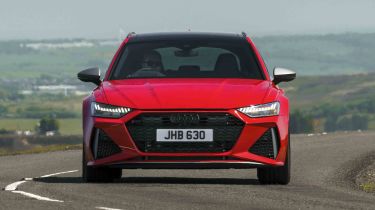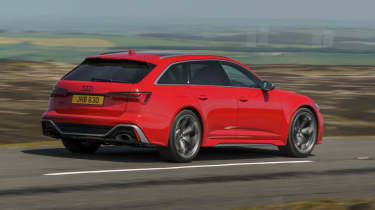Audi RS 6 Avant - Engines, performance and drive
Despite the RS 6’s mild hybrid-tech, there’s nothing mild about the performance

Engage launch control in the Audi RS 6 and you’ll experience instant power delivery as 621bhp is sent to the tarmac via Audi’s quattro four-wheel drive system. The engine and transmission are so incredibly proficient that this remarkable estate will provide supercar-baiting performance if required, but can also behave in an effortless way when not in maximum attack mode, allowing the car to move down the road in a relaxed fashion that could almost make you forget about the extreme performance that’s on offer.
|
Model |
Power |
0-62mph |
Top speed |
|
RS 6 Avant Performance |
621bhp |
3.4 seconds |
174mph |
|
RS 6 Avant GT |
621bhp |
3.3 seconds |
190mph |
What is the Audi RS 6 Avant like to drive?
In town
The RS 6 Avant features all-wheel steering, making the car more manoeuvrable at low speed because the rear wheels turn in the opposite direction to the fronts. This helps to reduce the car’s turning circle and make parking manoeuvres just that little bit easier.
Remarkably given the huge 22-inch wheels that come as standard, the ride isn’t jarring over bumps and potholes. We would suggest you keep the drive mode in its comfort setting when trundling around town, because the sportier drivetrain settings might make the accelerator response a bit too snappy at times when exiting a junction or merging on to a roundabout for some.
On A- and B-roads
At higher speeds, the four-wheel steering system makes the rear wheels follow the movement of the front wheels, improving agility so that the car feels more precise, although the steering detracts from this a little by feeling artificially weighty if you select dynamic mode.
Used - available now
Traction is superb, while the huge torque gives plenty of flexibility. However, those who like to seek-out the occasional fast, twisty road may find the big estate lacking a little in feel, and the automatic gearbox can take a moment when left to its own devices before it decides to change down.
There is a choice in suspension set-up in the RS 6, with either standard air suspension or the Vorsprung model’s steel springs with adaptive dampers. The latter offers a more settled ride at all speeds and body control is noticeably improved. Any car weighing nearly 2,100kg is going to experience some roll, but the Dynamic Dide Control system helps keep it more in check.
On the motorway
The Audi RS 6 feels suitably settled at motorway speeds, especially when fitted with Dynamic Ride Control and steel springs. It avoids feeling floaty and has a precision that makes the car seem rock solid on the road. It’s more than capable of remaining that way should you find yourself on a derestricted Autobahn where you can test out its top speed.
Despite losing some 8kg of sound insulation to allow for more engine and exhaust noise to enter the interior, road noise in the RS 6 isn’t too bad. This is despite the steamroller-sized wheels the RS 6 has. Wind noise is nicely subdued at speed, too.
Engines, 0-60 acceleration and top speed
With 621bhp and 850Nm of torque, this remarkable estate will crack 0-62mph in 3.4 seconds and go on to a maximum of 174mph. The small weight reduction of the GT version yields a marginally quicker 3.3-second acceleration sprint, while a higher speed limit will allow you to reach 190mph.
There are the ‘RS1’ and ‘RS2’ modes, which are offered in addition to the standard driving profiles and allow the driver to customise the car’s set-up to suit their individual preferences. Once this is stored, the profile can then be engaged at any time by pressing the RS Mode button on the steering wheel.
Despite the ferocious power at hand, there has been some attention paid to efficiency. The twin-turbo 4.0-litre V8 comes with a 48-volt mild hybrid system, to help improve response and efficiency. The hybrid function enables gliding with the engine switched off, fast restart and an intelligent drive management system that uses the navigation map to decide whether coasting is more fuel-efficient.













